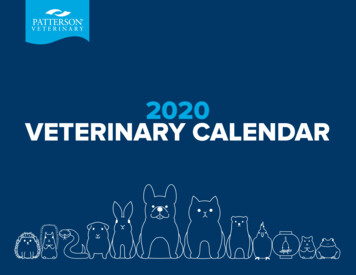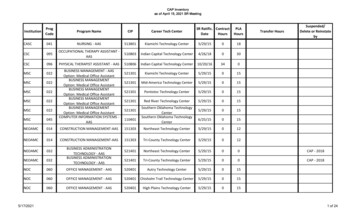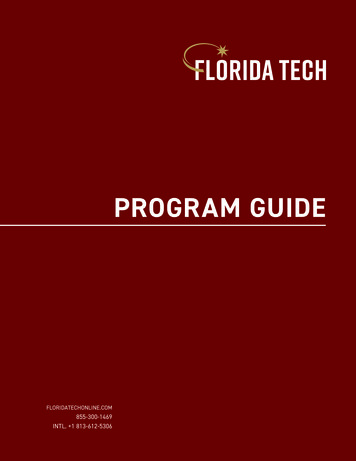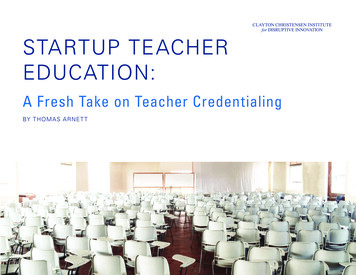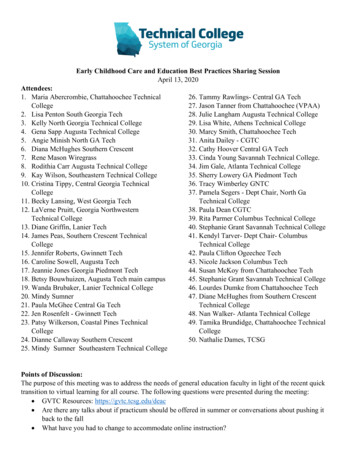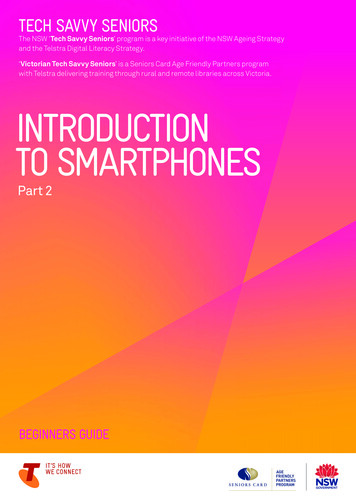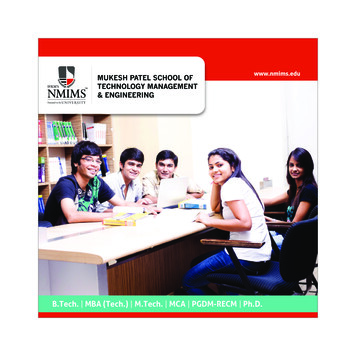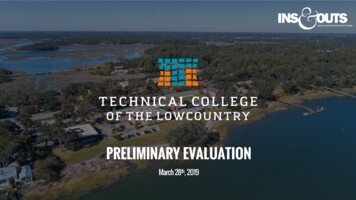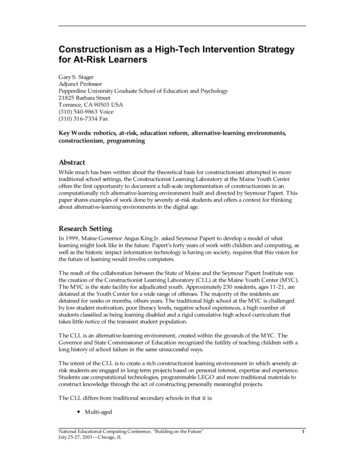
Transcription
Constructionism as a High-Tech Intervention Strategyfor At-Risk LearnersGary S. StagerAdjunct ProfessorPepperdine University Graduate School of Education and Psychology21825 Barbara StreetTorrance, CA 90503 USA(310) 540-9863 Voice(310) 316-7334 FaxKey Words: robotics, at-risk, education reform, alternative-learning environments,constructionism, programmingAbstractWhile much has been written about the theoretical basis for constructionism attempted in moretraditional school settings, the Constructionist Learning Laboratory at the Maine Youth Centeroffers the first opportunity to document a full-scale implementation of constructionism in ancomputationally rich alternative-learning environment built and directed by Seymour Papert. Thispaper shares examples of work done by severely at-risk students and offers a context for thinkingabout alternative-learning environments in the digital age.Research SettingIn 1999, Maine Governor Angus King Jr. asked Seymour Papert to develop a model of whatlearning might look like in the future. Papert’s forty years of work with children and computing, aswell as the historic impact information technology is having on society, requires that this vision forthe future of learning would involve computers.The result of the collaboration between the State of Maine and the Seymour Papert Institute wasthe creation of the Constructionist Learning Laboratory (CLL) at the Maine Youth Center (MYC).The MYC is the state facility for adjudicated youth. Approximately 230 residents, ages 11-21, aredetained at the Youth Center for a wide range of offenses. The majority of the residents aredetained for weeks or months, others years. The traditional high school at the MYC is challengedby low student motivation, poor literacy levels, negative school experiences, a high number ofstudents classified as being learning disabled and a rigid cumulative high school curriculum thattakes little notice of the transient student population.The CLL is an alternative-learning environment, created within the grounds of the MYC. TheGovernor and State Commissioner of Education recognized the futility of teaching children with along history of school failure in the same unsuccessful ways.The intent of the CLL is to create a rich constructionist learning environment in which severely atrisk students are engaged in long-term projects based on personal interest, expertise and experience.Students use computational technologies, programmable LEGO and more traditional materials toconstruct knowledge through the act of constructing personally meaningful projects.The CLL differs from traditional secondary schools in that it is: Multi-agedNational Educational Computing Conference, “Building on the Future”July 25-27, 2001—Chicago, IL1
r-centeredWhile some efforts at school reform have embraced one or two of the ideas mentioned above, fewpublic schools have attempted to eliminate age segregation and compartmentalized curricula whilesupporting project-based learning, reflective practice and ubiquitous computing simultaneously.The CLL combines the theory of constructionism with powerful ideas from the school reformmovement.Each CLL student has a personal computer and access to a variety of materials. Students areexpected to engage in personal and collaborative learning projects in which they constructknowledge, often by making something tangible. Some student artifacts have included a variety ofrobots, video games, plays, poetry, claymation movies, hand-crafted wooden guitars, ultra-lightgliders, digital films. The students enjoy access to an extensive classroom library and constructivematerial including programmable LEGO.The projects connect student interests and experience with powerful ideas through aspects of theengineering process—tinkering, prototyping, testing, building, debugging and the presentation ofa finished product. The teacher's role is to support the students in the construction of theirprojects and help learners make explicit connections to the important scientific, mathematical,historical or artistic ideas implicit in their work.In his most recent book, The Connected Family (1996), Papert states, “nothing beautiful is forced.”The CLL strives to create an environment in which young people are engaged constructively, butwithout the coercion so often associated with traditional curricula. The absence of a bell schedule,tests and artificially segregated subject-area classes allows students to make connections betweendisciplines. They can work in depth on personally meaningful projects without the disruptionsassociated with high-stakes testing or competition fostered by traditional schooling. Students havethe time to make mistakes, redefine their goals and develop the technological fluency required forrealizing their objectives. Reflective practice is an important part of this learning process. Studentsare encouraged to document their own learning through personal portfolios, sketches,photography, videotape and contributions to the class’ newsletter. The social culture of the CLLvalues collaboration, idea sharing and a sense of community. These skills are critical for a successfullife, but may have been rarely experienced by the teens in the Youth Center.A full-time teacher and a ‘special projects leader’ work with the students on a daily basis whilevolunteers and experts are brought in to lead occasional week-long immersive workshops. Studentshave already enjoyed such intensive workshops in drama, film-making, African drumming,electronics, radio journalism, career preparation and video game design. Skills and insights gainedduring these residencies are then used by students in their personal projects. Visitors also play acritical role in the professional development and continuous inspiration of the full-time teachers.Regular impromptu visitor “demos” provide opportunities for students to exhibit and explain theirlearning.Brief mini-tutorials might be organized to teach specific MicroWorlds Pro programming conceptsor explain scientific principles. Such instruction is designed to assist students in developing theirown technological fluency in service of the development of increasingly sophisticated projects. As aresult, students are able to express themselves and their ideas through a rich array of tools,strategies and media. The CLL has allowed many children to feel intellectually powerful andcreatively expressive for perhaps the first time in their lives. A desk similar to the one pictured inFigure 1 might be found in the office of a great scientist or noted intellectual. This desk belongs toa CLL student misclassified by the traditional school system as illiterate.National Educational Computing Conference, “Building on the Future”July 25-27, 2001—Chicago, IL2
Figure 1In the CLL the personal computer is truly personal. All students have their own and use them as amedium for constructing new things, a portfolio for keeping track of their own progress, anintellectual laboratory and a vehicle for self expression. Students program in MicroWorlds Pro,control robots with Yellow Brick Logo, edit video, publish newsletters and document their learningprocesses via the computer.Computing in the CLL differs from many of the fads and fetishes associated with educationalcomputing. Children use computers to build interesting things, document processes, experiment,tinker and share newly constructed knowledge. CLL students are active knowledge workers ratherthan passive recipients of content produced by others. The emphasis is neither on computerliteracy or web surfing.Theoretical BackgroundConstructionismConstructivist learning theory is associated with the work of Jean Piaget and Lev Vygotsky.Constructivists argue that knowledge is not transmitted, but constructed. Each individual mustreconstruct knowledge and this learning process happens within a material environment, a cultureand a supportive community of practice. While constructivism defines learning as the building ofknowledge structures inside of one’s head, constructionism suggests that the best way to ensure thatsuch intellectual structures form is through the active construction of something outside of one'shead, that is something tangible, something shareable.Where constructivism could be simply expressed as learning by doing, constructionism is learningby making. However, Papert’s play-on-words is a deliberate attempt to both extend the notion ofconstructivism and offer a critique of its misuse in thinking about schooling. Papert is critical ofhow constructivism may be interpreted to mean the construction of knowledge without a contextof use. This disassociation of knowledge without the context of use may contribute to weakerunderstanding, coercive curriculum and negative attitudes towards learning.National Educational Computing Conference, “Building on the Future”July 25-27, 2001—Chicago, IL3
In attempts to implement constructivist theory, teachers and curriculum designers often createsituations in which a student will “discover” a particular concept, rule or fact without anyauthentic context or motivation for making such a discovery. The deliberate attempt of one personto “lead another to discover” a concept deprives the learner of a powerful intellectual adventure.Piaget’s powerful idea that all learning takes place by discovery is emasculated when school practicetranslates this idea into “discovery learning”. This idea is disempowered when it is orchestrated bythe preset agenda of a curriculum. Learning is also weakened because the ideas being learned aredisempowered by the act of removing them from a context for authentic discovery arising fromneed or serendipity. Constructionists are concerned with the goal of re-empowering the powerfulideas learned by students by taking a step towards re-empowering the idea of learning by discovery.(Papert 2000) Elaborate “real world” scenarios created by educators often do great violence to theimportant idea that knowledge is situated, by forcing students to confront a concept they see tohave little relevance now or in the future of their high-tech society.Papert argues that cognitivists also misinterpret constructivism by believing that a student willlearn better by understanding the intellectual methods used for solving a particular problem if sheunderstands the concepts behind them. This might be so if the student appreciates the beauty orpower of those ideas, but in too many cases the cognitivist is trying to get the student to see theconnection between one set of ideas about which she does not care and another. The cognitivistdoes little to create an environment in which a student can experience the same intellectualsituation in which those ideas were invented. This may lead ultimately to weaker understanding ofthat concept and a poorer concept of the individual as a capable learner.The theoretical basis for the CLL develops from Papert's work most completely described in hisbooks Mindstorms: Children, Computers and Powerful Ideas (1981), The Children’s Machine (1993)and The Connected Family (1997). These seminal books in the field of educational computingdetail more than four decade’s worth of thinking about learning with computers.Constructionism predicts that individuals learn best by mobilizing their entire selves in apersonally meaningful pursuit while sensing that their work is valued as part of a larger enterprise.This type of learning is hard, long-lasting and requires more time than is typically afforded by thebifurcated secondary school curriculum.Constructionists argue that learning is active and superior to a pedagogy of learning by telling.They value a plurality of definitions, meanings and ways of knowing. Learning is highly personaland controlled by the learner. Constructionists believe that learning requires taking a stance,seeking and finding one's intellectual identity, owning the artifacts of learning and finding yourown voice. (Harel 1993)Constructionists recognize an important role for technology in learning. The computer is aparticularly flexible, expressive and intellectually rich medium for “messing about” with powerfulideas. For learners, the computer provides an unrivaled intellectual laboratory and vehicle for selfexpression. The computer becomes the workspace within which students can, for example programvideo games, construct simulations, perform calculations, store their journals, publish newsletters,correspond with experts, edit video, produce animated films, learn to fly an airplane and muchmore.Powerful IdeasThe exploration, construction and articulation of powerful ideas are at the focus of aconstructionist learning environment. Seymour Papert believes that when ideas go to school they losetheir power. (Papert 2000) It is therefore the challenge of a constructionist learning environment tocreate situations in which students may not only discover powerful ideas, but perhaps the mostpowerful idea of all – the idea of powerful ideas.National Educational Computing Conference, “Building on the Future”July 25-27, 2001—Chicago, IL4
Students in a constructionist learning environment will eagerly investigate powerful ideas at theforefront of intellectual exploration and express their knowledge through the construction ofsophisticated long-term projects. It is believed that through the construction of personallymeaningful projects students will not only develop content-area knowledge, but the habits of mindand social skills required to make contributions to society in the twenty-first century.In The Having of Wonderful Ideas, Duckworth (1996) supports the educational efficacy of studentprojects when she says that intelligence cannot develop without matter to think about. Makingnew connections depends on knowing enough about something in the first place to provide a basisfor thinking of other things to do – of other questions to ask – that demand more complexconnections in order to make sense. The more ideas people already have at their disposal, the morenew ideas occur and the more they can coordinate to build up still more complicated schemes.This suggests that a child comfortable tinkering with familiar items and playing with ideas willgain the confidence and self-awareness required to solve a wide variety of problems.The CLL shares the sentiments of Newell who suggests that learning best occurs through aplethora of explorations that lead to: crossing subject boundariescrossing subject boundaries in fuzzy and unexpected waysavoiding the feelings; “I cannot learn!” “I am stupid” “I am not good enough at this”pursue things that fascinate youinnovation and inventionexplorations that feel like play. (Newell 1993)Project SignificancePersonal digital technologies offer a powerful medium for the construction of knowledge in a socialsetting. Earlier research supports the hypothesis that children are capable of constructingknowledge when using computational materials in a social setting.Harel demonstrated that children asked to learn traditional concepts in traditional schools weremore likely to gain a deeper understanding of those concepts if immersed in a constructionistactivity. The students in Harel’s research were asked to use Logo software and microcomputers todesign educational software that would teach another child about fractions. Questions remainabout the effect of limiting student learning to the arbitrary constraints of the curriculum. Theexisting body of research attempts to investigate the theory of constructionism in traditionalschools. In other words, constructionist activities were executed in relatively unchanged schools.Since constructionist theory addresses both the cognitive and social aspects of learning, it isimportant to research the application of the theory in an environment designed from the bottomup to reflect such principles. The learning environment embodied by the CLL addresses thechallenges associated with changes in the nature of teaching and learning, professionaldevelopment, curriculum, assessment and the use of personal computing in learning. Thesevariables reinforce one another and are impossible to address in isolation.While much has been written about the theoretical basis for constructionism attempted in moretraditional school settings, the CLL project offers the first opportunity to document a full-scaleimplementation of constructionism in an computationally rich alternative-learning environmentbuilt and directed by Papert. This represents another step towards defining constructionism as aviable learning theory.National Educational Computing Conference, “Building on the Future”July 25-27, 2001—Chicago, IL5
CLL Examples from the First YearCLL students use rich computational media like LEGO’s programmable RCX brick to constructfantastic inventions. Building with LEGO is the focus of many activities in the CLL. The LEGObricks, gears, motors, sensors and programmable brick create an improvisational medium in whichthe top-down planner and bricoleur (tinkerer) alike can explore powerful ideas in math, science,computer science by building something “real.”One student read newspaper articles detailing Coca Cola’s plans to test a new vending machinethat would charge more for a soft drink on hot days. Most CLL students thought this was unfair,but it was suggested that they could build a working prototype of the vending machine out ofLEGO. Although the student protested that he couldn’t build something that complicated, he anda classmate began work on the construction of such a device. Figure 2. Having triumphantlyconstructed and programmed a successful temperature-sensitive Coke machine, the studentproceeded to write a letter to the Chairman of Coca-Cola. The letter included photos of hisprototype and an offer to build a full-scale model. The student received a letter denying that thecompany had ever contemplated charging customers in such a way. The disappointed (and thirsty)student then put his letter alongside of the letter from Coca-Cola and the newspaper articlesannouncing the new machine in the class newsletter.Figure 2The same student then constructed an ingenious conveyor belt system designed to route baggage atan airport. Different color LEGO bricks were used to represent bags heading for one of fourairplanes. A light sensor was calibrated to report the amount of light reflected off each color brick.This data was used to ‘teach’ the programmable LEGO brick to automatically direct the baggage inone of four different directions. Countless engineering challenges dealing with ambient light,sensor errors, gearing, timing and structural concerns had to be overcome in order to construct thebrilliant piece of robotic engineering pictured in Figure 3.National Educational Computing Conference, “Building on the Future”July 25-27, 2001—Chicago, IL6
Figure 3Students build robotic arms, machines that play the xylophone, robot sumo wrestlers, machinesthat can mechanically write their name and gearboxes that can pull impressive quantities of massFigures 4 and 5. They are expected to explain their inventions and the process they experiencedconstructing a working device. Learners use various media to document their learning processesand to archive their finished product in an attempt to demonstrate their knowledge and reflect ontheir learning.Figure 4National Educational Computing Conference, “Building on the Future”July 25-27, 2001—Chicago, IL7
Figure 5Technology is a ubiquitous part of the lives of kids and should be reflected in their learningexperiences. Young people have a casual relationship with technology and can even be quite playfulwith it. An example of this playfulness is embodied in the digital gingerbread houses built by CLLstudents at Christmas time. Each child built a house of graham crackers, icing, cookies, candy anda small computer tucked away inside. Their houses had twinkling lights, programmed carolsperformed by the LEGO brick, doorbells and spinning trees made of Hershey Kisses. Figure 6Figure 6Is this cheating or just good science?Themes often link a variety of projects and connect the learning experiences to a larger body ofknowledge. A theme unifies individual discoveries and makes explicit connections between implicitknowledge. Themes may be related to content areas such as optics or organized around a challenge.One such theme involved challenging the students to build a LEGO vehicle capable of climbingthe steepest ramp.National Educational Computing Conference, “Building on the Future”July 25-27, 2001—Chicago, IL8
The competitive nature of this challenge led students to construct countless vehicles. Observationsand data collected from previous attempts guided the systematic development of moresophisticated devices. Students soon understood that there were only four causes of failure: toomuch friction; too little force; center of gravity; structural inadequacy (it busts apart). Suchimportant scientific principles guided significant improvements in subsequent vehicles.One girl decided to put sandpaper on the ramp to see if it would aid in the climbing effort. Theyoung engineer tried different grades of sandpaper and when she found the sandpaper responsiblefor the best climbing she decided to investigate the reasons why. The sandpaper and LEGO tirewere examined under a microscope. Had this been an ordinary microscope no discovery wouldhave been made. The Intel QX3 microscope allowed the student to print out the magnified imagesof the two surfaces. By looking at these printouts side-by-side the student was able to see that thesurface of the tire and sandpaper were similar enough to work like teeth in two gears – therebyallowing the vehicle with those tires to climb a ramp made of that surface. This “eureka” momentmight not have occurred in a traditional classroom without microscopes or with an analogmicroscope incapable of printing a magnification.A group of students noticed that their vehicle attempted to climb the wall after reaching the top ofthe ramp. This observation inspired many additional explorations, including the question ofbuilding a vehicle that could climb an incline greater than ninety degrees. One ingenious studentasked the teacher what she meant by “climb the ramp?” She improvised an answer that “climbingthe ramp meant that the front wheels of the vehicle had to cross a particular line.” He asked if shewere sure and when satisfied with the ruling set-off to defy physics by constructing a vehiclecapable of climbing an incline of approximately 110 degrees. The result may be seen in Figure 7.Figure 7While traditional curricula would allow a teacher to check off “uses a protractor” from a list ofobjectives, the kids in the CLL learned so much more. Students attempting to “win” the rampclimbing challenge learned a great deal about perseverance, debugging, gearing, limits, scientificconventions, programming, force, friction, magnification, center of gravity, structures, thescientific method and many more powerful ideas by doing science rather than being taught aboutscience.National Educational Computing Conference, “Building on the Future”July 25-27, 2001—Chicago, IL9
Views of a student invention designed to graph fluctuations in outside temperature over a several dayperiod.The CLL does not focus exclusively on the use of computers by students. Kids read books, writeplays, produce videos and publish newsletters. In fact, exciting work has been done with wood.Under the direction of John Stetson, CLL kids have built beautiful handcrafted classical guitars.These instruments are complete with wood inlay and reflect a level of precision usually reserved formaster craftspeople. These guitars require hundreds of hours of careful labor and provideopportunities to confront challenges like humidity. Kids learned that if the humidity is not withina certain range, their wood may swell or crack. Humidity was not merely a vocabulary word forthem, but rather a force of nature they needed to overcome. The construction of ultralightairplanes capable of flying for minutes unpowered, handmade telescopes and camera obscuras offerthese learners opportunities to better understand the world around them. It is hoped that thesepowerful experiences provide students with a way of viewing the world so they may live happilyand make important contributions to the world of ideas.The CLL offers a model of constructionism complete with ubiquitous digital technology andimportant school reform strategies with a population of at-risk students. The lessons learned fromthis project should benefit all populations of learners. The goal is to engage children inunprecedented learning activities while offering the world a new way of thinking about creatinglearning environments for the 21st Century.ReferencesCavallo, D. (1999) “Project Lighthouse in Thailand: Guiding Pathways to PowerfulLearning.” In Logo Philosophy and Implementation. Montreal, Canada: LCSI.Duckworth, E. (1996) The Having of Wonderful Ideas and Other Essays on Teaching andLearning. NY: Teachers College Press.Edwards, C., Gandini, L. and Forman, G. (1998) The Hundred Languages of Children: TheReggio Emilia Approach—Advanced Reflections. Norwood, NJ: Ablex Publishing.National Educational Computing Conference, “Building on the Future”July 25-27, 2001—Chicago, IL10
Harel, I. (1991) Children Designers : Interdisciplinary Constructions for Learning and KnowingMathematics in a Computer-Rich School. Norwood, NJ: Ablex Publishing.Harel, I. (1993) “Who is a Constructionist?” a paper presented at the International LogoConference, July 1993. Melbourne, Australia.Harel, I., and Papert, S., eds. (1991) Constructionism. Norwood, NJ: Ablex Publishing.Harel, I. and Papert, S. (1991) “Situating Constructionism” in Constructionism. Norwood, NJ:Ablex Publishing.Kafai, Y., and Resnick, M., eds. (1996) Constructionism in Practice: Designing, Thinking, andLearning in a Digital World. Mahwah, NJ: Lawrence Erlbaum.Newell, B. (1993) Untitled keynote address at the International Logo Conference. July 1993,Melbourne, Australia.Papert, S. (1980) Mindstorms: Children, Computers, and Powerful Ideas. New York: BasicBooks.Papert, S. (1990) “A Critique of Technocentrism in Thinking About the School of theFuture,” MIT Epistemology and Learning Memo No. 2. Cambridge, Massachusetts:Massachusetts Institute of Technology Media Laboratory.Papert, S. (1991) “Situating Constructionism.” In Constructionism, in Harel, I., and Papert, S.,eds. Norwood, NJ: Ablex Publishing.Papert, S. (1993) The Children's Machine: Rethinking School in the Age of the Computer. NewYork: Basic Books.Papert, S. (1996) The Connected Family. Atlanta: Longstreet Publishing.Papert, S. (1999) “The Eight Big Ideas of the Constructionist Learning Laboratory.”Unpublished. Portland, Maine.Papert, S. (1999) “What is Logo? Who Needs it?” In Logo Philosophy and Implementation.Montreal, Canada: LCSI.Papert, S. (2000) “What’s the Big Idea? Steps toward a pedagogy of idea power.” IBM SystemsJournal, Vol. 39, Nos 3&4, 2000.Resnick, M. and Ocko, S. (1991) “LEGO/Logo: Learning Through and About Design.” InConstructionism, in Harel, I., and Papert, S., eds. Norwood, NJ: Ablex Publishing.Turkle, S. (1991) “Epistemological Pluralism and the Revaluation of the Concrete.” InConstructionism. Idit Harel and Seymour Papert (eds.), Norwood, NJ: Ablex Publishing.Weisman Topal, C. and Gandini, L. (1999) Beautiful Stuff – Learning with Found Materials.Worcester, Massachusetts: Davis Publishing.National Educational Computing Conference, “Building on the Future”July 25-27, 2001—Chicago, IL11
The result of the collaboration between the State of Maine and the Seymour Papert Institute was the creation of the Constructionist Learning Laboratory (CLL) at the Maine Youth Center (MYC). The MYC is the state facility for adjudicated youth. Approximately 230 residents, ages 11-21, are detained at the Youth Center for a wide range of offenses.
